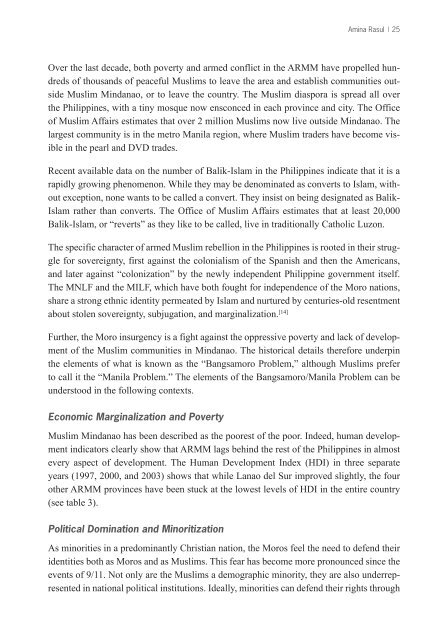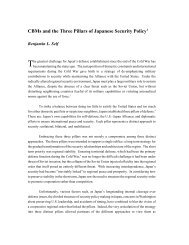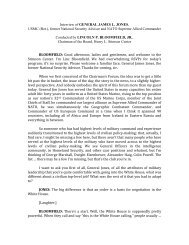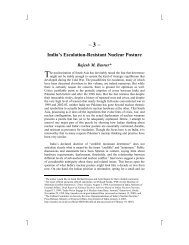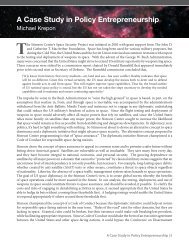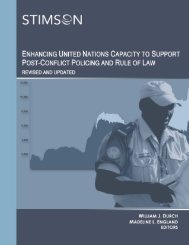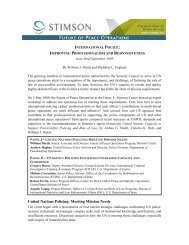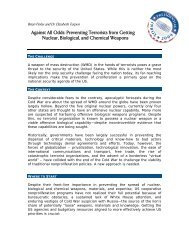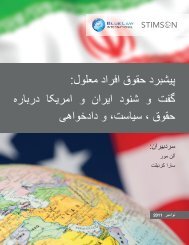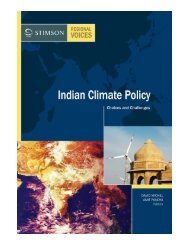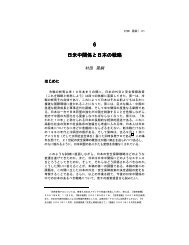Islam and Politics - The Stimson Center
Islam and Politics - The Stimson Center
Islam and Politics - The Stimson Center
Create successful ePaper yourself
Turn your PDF publications into a flip-book with our unique Google optimized e-Paper software.
Amina Rasul | 25<br />
Over the last decade, both poverty <strong>and</strong> armed conflict in the ARMM have propelled hundreds<br />
of thous<strong>and</strong>s of peaceful Muslims to leave the area <strong>and</strong> establish communities outside<br />
Muslim Mindanao, or to leave the country. <strong>The</strong> Muslim diaspora is spread all over<br />
the Philippines, with a tiny mosque now ensconced in each province <strong>and</strong> city. <strong>The</strong> Office<br />
of Muslim Affairs estimates that over 2 million Muslims now live outside Mindanao. <strong>The</strong><br />
largest community is in the metro Manila region, where Muslim traders have become visible<br />
in the pearl <strong>and</strong> DVD trades.<br />
Recent available data on the number of Balik-<strong>Islam</strong> in the Philippines indicate that it is a<br />
rapidly growing phenomenon. While they may be denominated as converts to <strong>Islam</strong>, without<br />
exception, none wants to be called a convert. <strong>The</strong>y insist on being designated as Balik-<br />
<strong>Islam</strong> rather than converts. <strong>The</strong> Office of Muslim Affairs estimates that at least 20,000<br />
Balik-<strong>Islam</strong>, or “reverts” as they like to be called, live in traditionally Catholic Luzon.<br />
<strong>The</strong> specific character of armed Muslim rebellion in the Philippines is rooted in their struggle<br />
for sovereignty, first against the colonialism of the Spanish <strong>and</strong> then the Americans,<br />
<strong>and</strong> later against “colonization” by the newly independent Philippine government itself.<br />
<strong>The</strong> MNLF <strong>and</strong> the MILF, which have both fought for independence of the Moro nations,<br />
share a strong ethnic identity permeated by <strong>Islam</strong> <strong>and</strong> nurtured by centuries-old resentment<br />
about stolen sovereignty, subjugation, <strong>and</strong> marginalization. [14]<br />
Further, the Moro insurgency is a fight against the oppressive poverty <strong>and</strong> lack of development<br />
of the Muslim communities in Mindanao. <strong>The</strong> historical details therefore underpin<br />
the elements of what is known as the “Bangsamoro Problem,” although Muslims prefer<br />
to call it the “Manila Problem.” <strong>The</strong> elements of the Bangsamoro/Manila Problem can be<br />
understood in the following contexts.<br />
Economic Marginalization <strong>and</strong> Poverty<br />
Muslim Mindanao has been described as the poorest of the poor. Indeed, human development<br />
indicators clearly show that ARMM lags behind the rest of the Philippines in almost<br />
every aspect of development. <strong>The</strong> Human Development Index (HDI) in three separate<br />
years (1997, 2000, <strong>and</strong> 2003) shows that while Lanao del Sur improved slightly, the four<br />
other ARMM provinces have been stuck at the lowest levels of HDI in the entire country<br />
(see table 3).<br />
Political Domination <strong>and</strong> Minoritization<br />
As minorities in a predominantly Christian nation, the Moros feel the need to defend their<br />
identities both as Moros <strong>and</strong> as Muslims. This fear has become more pronounced since the<br />
events of 9/11. Not only are the Muslims a demographic minority, they are also underrepresented<br />
in national political institutions. Ideally, minorities can defend their rights through


